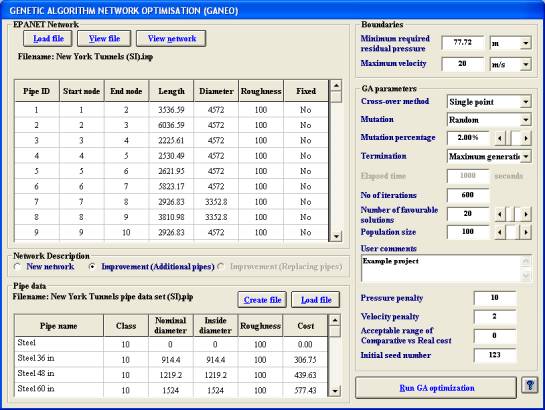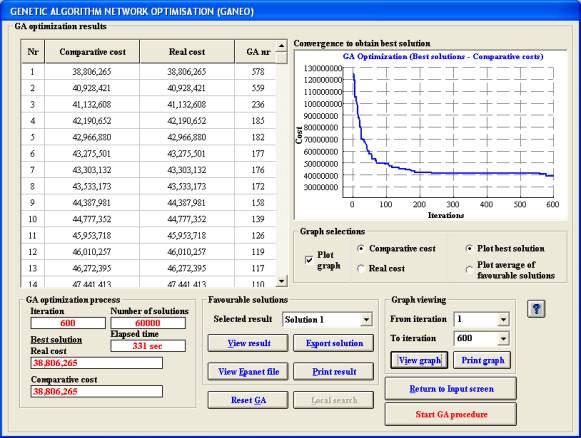Application and Conceptual
Development of Genetic Algorithms for Optimization in the Water Industry
Report No. 1388/1/05
March 2005
Executive Summary
Background and motivation
In the previous study, WRC Project K1144 –
“POTENTIAL APPLICATION OF GENETIC ALGORITHMS IN THE WATER
INDUSTRY”, the application of Genetic Algorithms was
reviewed. Findings from that study indicated that:
- GAs are not used to its full potential in the optimisation
in the water industry in South Africa,
- Potential applications of the technique within the South
African context are:
- Hydrology and water
resources assessment,
- Network optimisation,
- Optimisation of
rehabilitation, extension and upgrading of distribution networks during
the planning and design phase,
- Operation and maintenance
scheduling
- Little
formal
teaching on GAs is included in the curriculum of civil engineering,
- Feedback
from
Rand Water reflected the need for the development of software utility
programs that can be used in practice and stimulate the further
exploitation of this technique,
- The pipeline
diameter optimisation program that had been developed under this study
was well accepted in practice.
Objectives of this study
This study evaluated the application of genetic algorithms in the
optimisation of different components of water supply projects and
conceptually developed the procedures for the implementation thereof.
Based on the available literature study, as well as the feedback from
water supply authorities, the need for the application of GAs as an
optimisation technique in the water industry was defined. The
potential applications of GAs in the water industry in South Africa are:
- Hydrology and water
resources assessment,
- Network optimisation,
- Optimisation of
rehabilitation, extension and upgrading of distribution networks during
the planning and design phase,
- Operation and maintenance
scheduling
This study objective was to provide the conceptual development of
procedures to implement GAs as an optimisation technique
for water
resources assessment and network optimisation.
Methodology
The focus of this study was to conceptualise the optimisation problems
that were identified and to conceptually develop the required
procedures for the implementation of GAs in these areas in a follow-up
study.
Literature on optimisation techniques was reviewed, problem variables
and interdependence were identified and the GA operators for these
problems were conceptually described.
In the case of the network optimisation the GA procedures were coded
and software was developed and tested for network optimisation. The GA
Water Utility programs, GANEO, can be used for the assessment and
optimisation networks (Rehabilitation, replacement, placement of
parallel pipes or the assessment of new networks).
Results
The use of GA has been conceptually developed for water resources
assessment where the WRYM (Water Resources Yield Model) and WRPM (Water
Resources Planning Model) are used. Conceptual models for
applying the GA procedure to network optimization and operational
optimization problems have also been developed.
A GA front-end interface (see Figure
i) for the public domain software,
EPANET, has been developed that optimizes water distribution
systems. The results of the developed optimization procedure
were tested against benchmark problems that have been reviewed by
numerous International Researchers. The results are extremely
promising and the optimization process’s computational time
was reduced (Figure ii).
Figure i: Water distribution
network optimization software (GANEO)
Figure ii: Results obtained in
GANEO (various optimized system
solutions)
This inclusion of the GA
procedure for the network optimisation
provides the opportunity for the optimisation of new networks,
refurbishment of existing networks or the evaluation of the extension
to existing networks.
International benchmark problems were analysed with the utility, in all
cases providing the same or an improved optimal solutions in a much
shorter computational time.
The GANEO software is capable to solve the following objectives for any
complex network:
- Find a solution that meets
the minimum pressure requirements at every node,
- Find a solution that meets
the maximum velocity criteria set for each pipe, and
- Minimize the capital cost
Recommendation
In this study the conceptual procedures for GAs has been developed for:
- Pump optimisation and
operational scheduling,
- Water Resources assessment
and
- Water distribution networks.
These developments created the opportunity of conceptualising the
problems and now require the extension of the study to develop the
utilities to implement these concepts and create interfaces with
existing software.
It is recommended that the following aspects should be attended to:
- Conceptual development of a
genetic algorithm multi-objective optimisation model for the
optimisation of water distribution systems specifically for rural
developments, combining design and operational objective functions,
including Life Cycle Costing analysis of networks.
- Utilization of the developed
GA Water Utility Programs in the design of a new water distribution
system in South Africa to illustrate/demonstrate its applicability and
benefits.
- Promote the inclusion of GA
techniques in the graduate program.
- The GA software should be
used to enhance the understanding of GA’s and transfer
knowledge to the water sector.
- Development of a GA
application for the optimisation of the operating rules between
reservoirs.
- Review and testing of
parameter values and alternative operators to improve the performance
of the GA procedure (mutation percentage, population size, crossover
methods etc.).
- Develop a generic inter
reservoir optimisation model.
The software program can be downloaded from either the WRC or the
University of Pretoria web sites (links below).
WRC - http://www.wrc.org.za
University of Pretoria -
http://www.up.ac.za/academic/civil/divisions/water/ga.html


